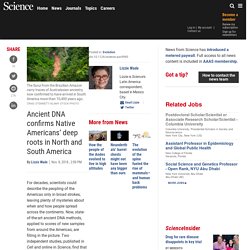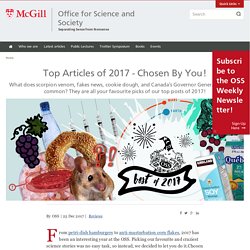

Evolution. Conspiracy theories. Pseudosci general. Science Progress. Quack/Alt medicine. Social media. GMOs. Anti vaxxers. Illusions. Climate change. Sciencemag. The data include 64 newly sequenced ancient DNA samples from Alaska to Patagonia, spanning more than 10,000 years of genetic history.

"The numbers [of samples] are just extraordinary," says Ben Potter, an archaeologist at the University of Alaska in Fairbanks. Prior to these studies, only six genomes older than 6000 years from the Americas had been sequenced. As a result, says Jennifer Raff, an anthropological geneticist at the University of Kansas in Lawrence, "The [genetic] models that we've been using to explain the peopling of the Americas have always been oversimplified. " Eske Willerslev, an evolutionary geneticist at the University of Copenhagen who led the Science team, worked closely with the Fallon Paiute-Shoshone Tribe in Nevada to gain access to some of the new samples. The tribe had been fighting to repatriate 10,700-year-old remains found in Nevada's Spirit Cave and had resisted destructive genetic testing.
It did. Sciencemag. ATLANTA—In the molecular dance that gave birth to life on Earth, RNA appears to be a central player.

But the origins of the molecule, which can store genetic information as DNA does and speed chemical reactions as proteins do, remain a mystery. Now, a team of researchers has shown for the first time that a set of simple starting materials, which were likely present on early Earth, can produce all four of RNA’s chemical building blocks. Those building blocks—cytosine, uracil, adenine, and guanine—have previously been re-created in the lab from other starting materials. In 2009, chemists led by John Sutherland at the University of Cambridge in the United Kingdom devised a set of five compounds likely present on early Earth that could give rise to cytosine and uracil, collectively known as pyrimidines.
Now, Carell says he may have the answer. “It looks pretty good to me,” says Steven Benner, a chemist with the Foundation for Applied Molecular Evolution in Alachua, Florida. Growing cancer drugs in chicken eggs could lower costs by 90% Top Articles of 2017 - Chosen By You! From petri-dish hamburgers to anti-masturbation corn flakes, 2017 has been an interesting year at the OSS.

Picking our favourite and craziest science stories was no easy task, so instead, we decided to let you do it.Chosen by YOU, below is a collection gathered from the McGill OSS website of our most popular articles, videos, and fun facts from 2017. Blue Scorpion Venom for Cancer? "Cancer patients from around the world have been travelling to Cuba for years to be treated for cancer with venom extracted from the blue scorpion. It all started in the 1980s when biologist Misael Bordier Chivas was carrying out experiments with animal toxins and found that the scorpion venom decreased the size of tumours in rats and dogs. Could there be something to the original version of the venom being effective? " Battle of the Milks: Are plant-based milks appropriate for children? Fake News and Money Making Schemes "The news these days is all about 'fake news.' #bagelscience...
The "Did You Know? "